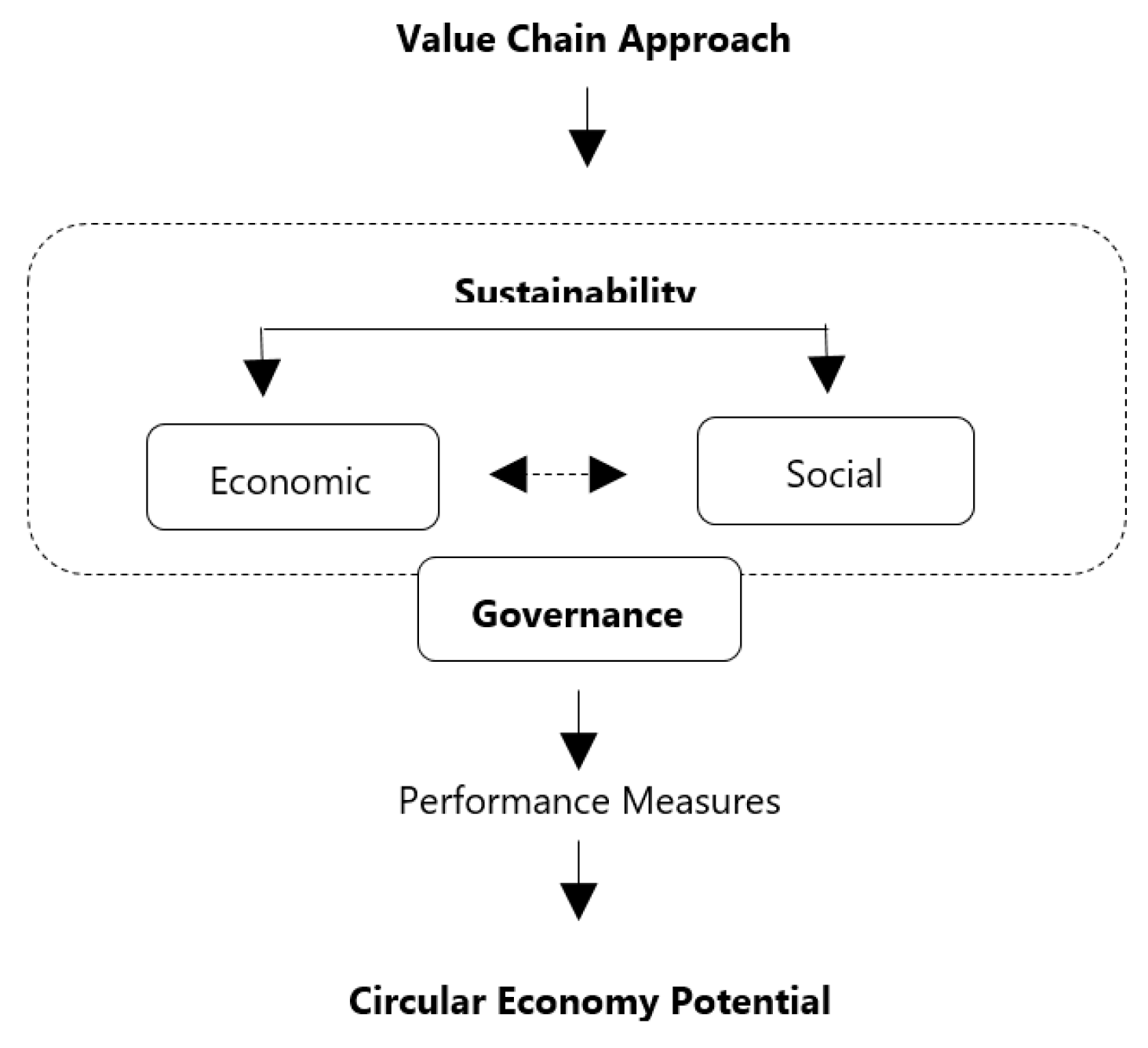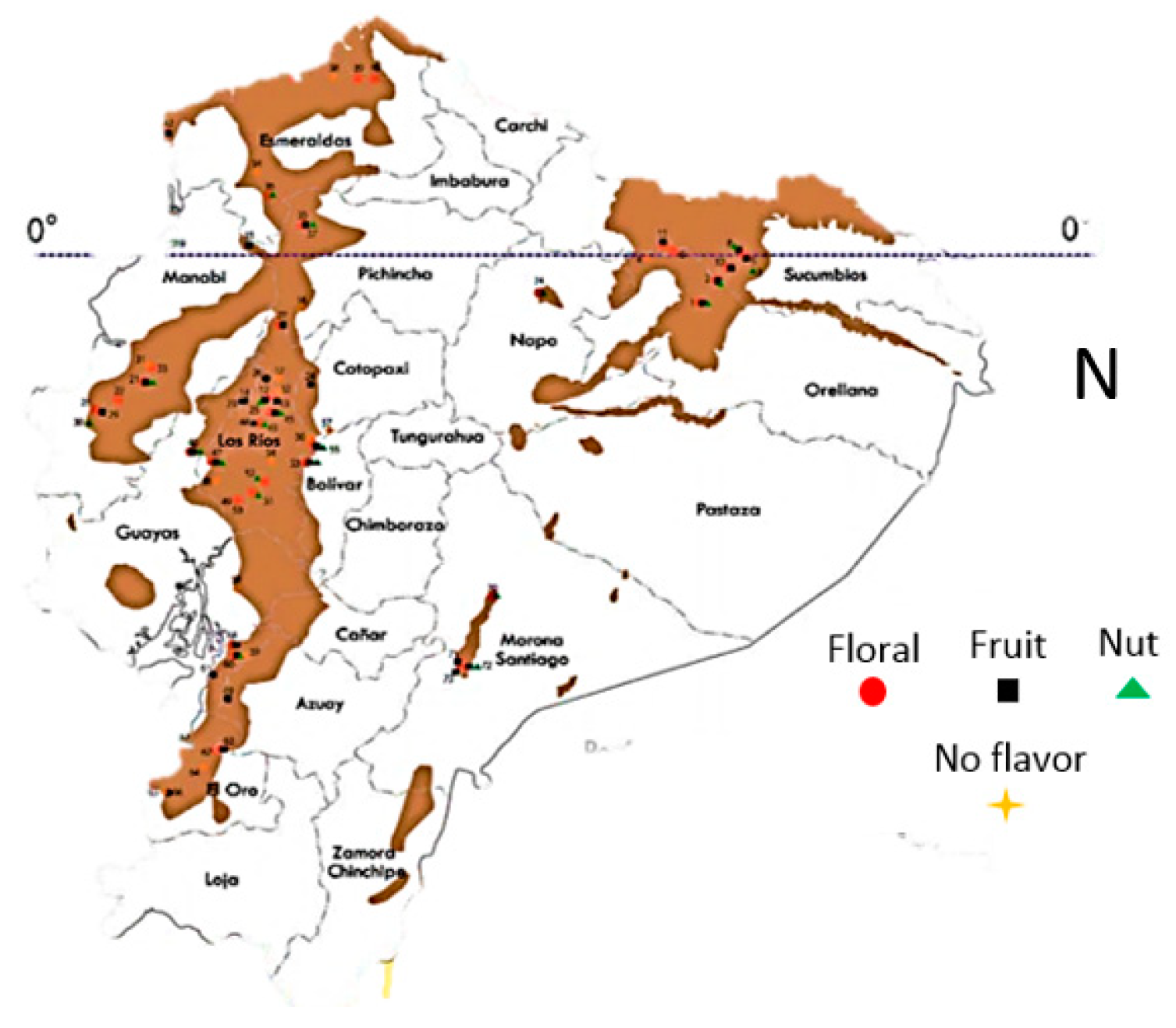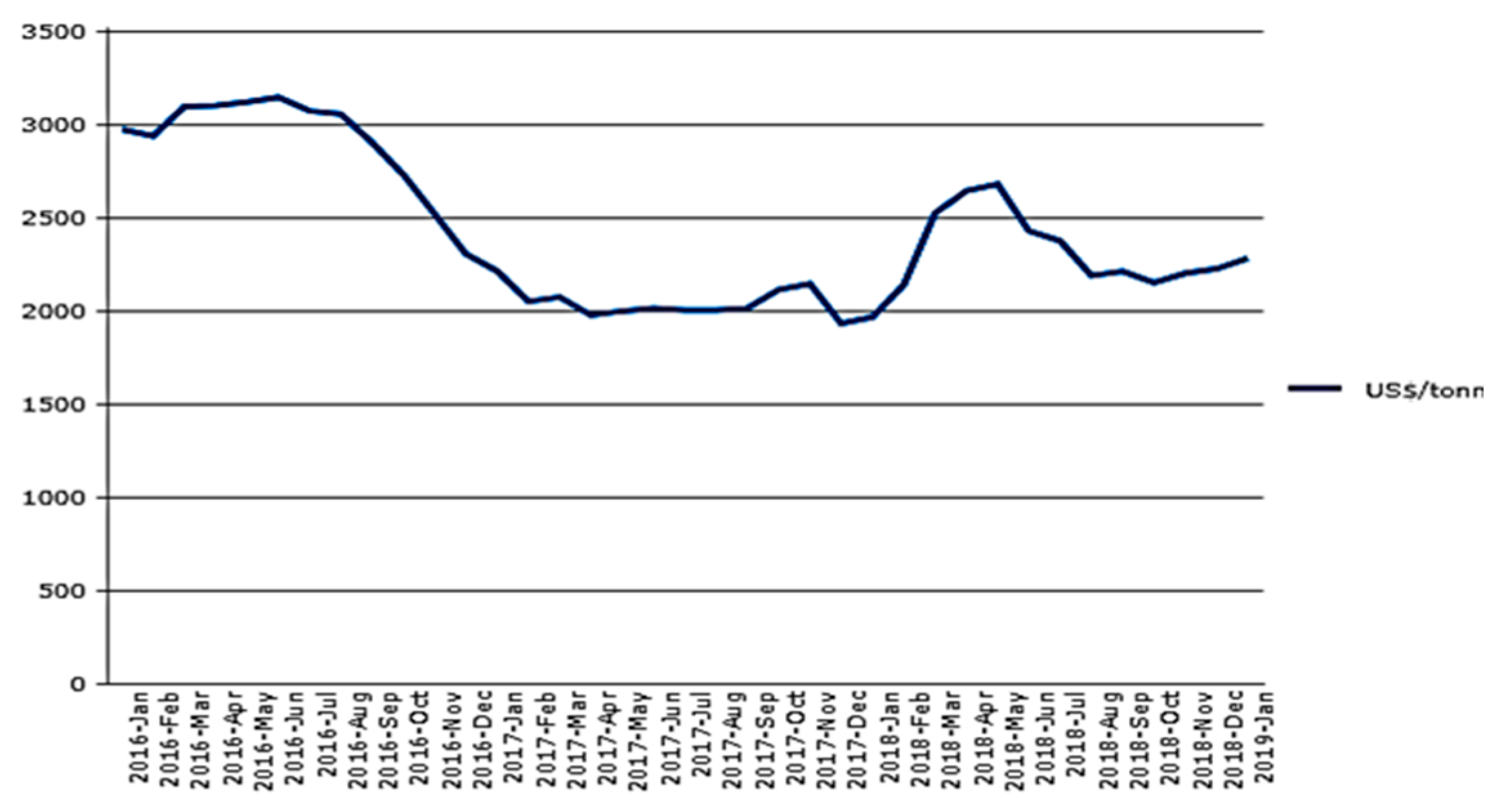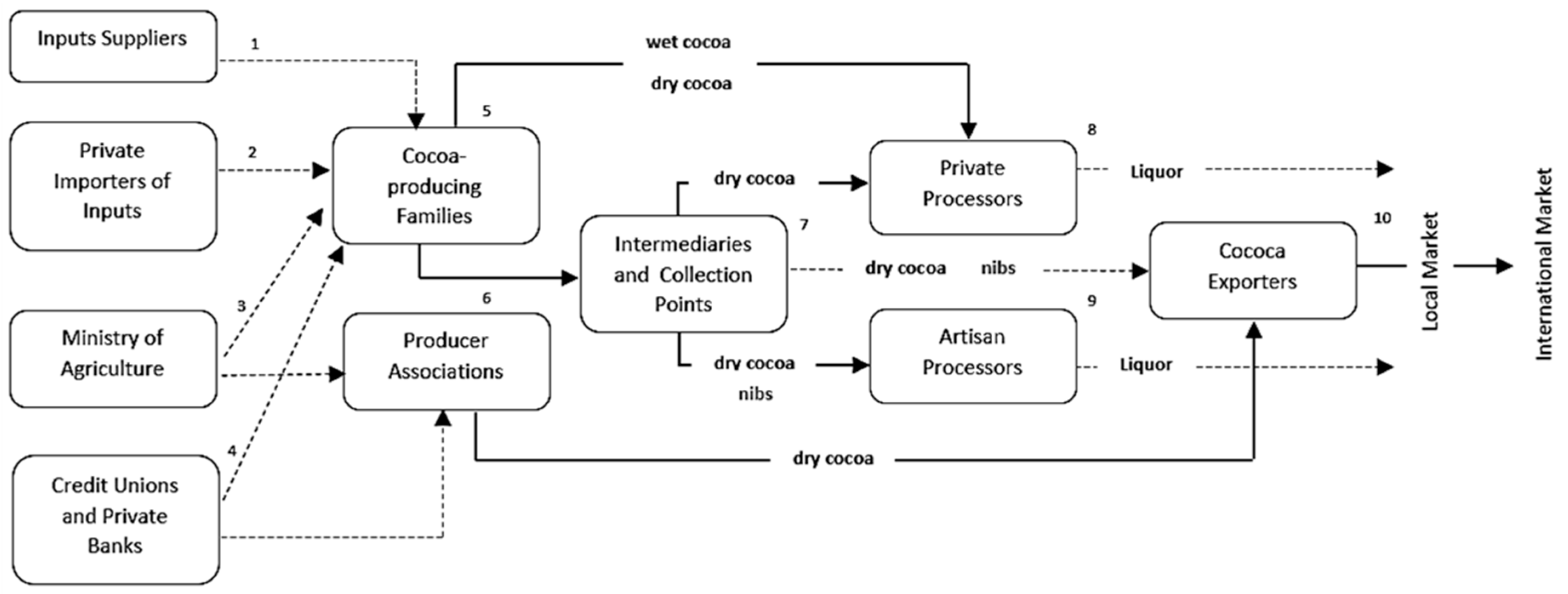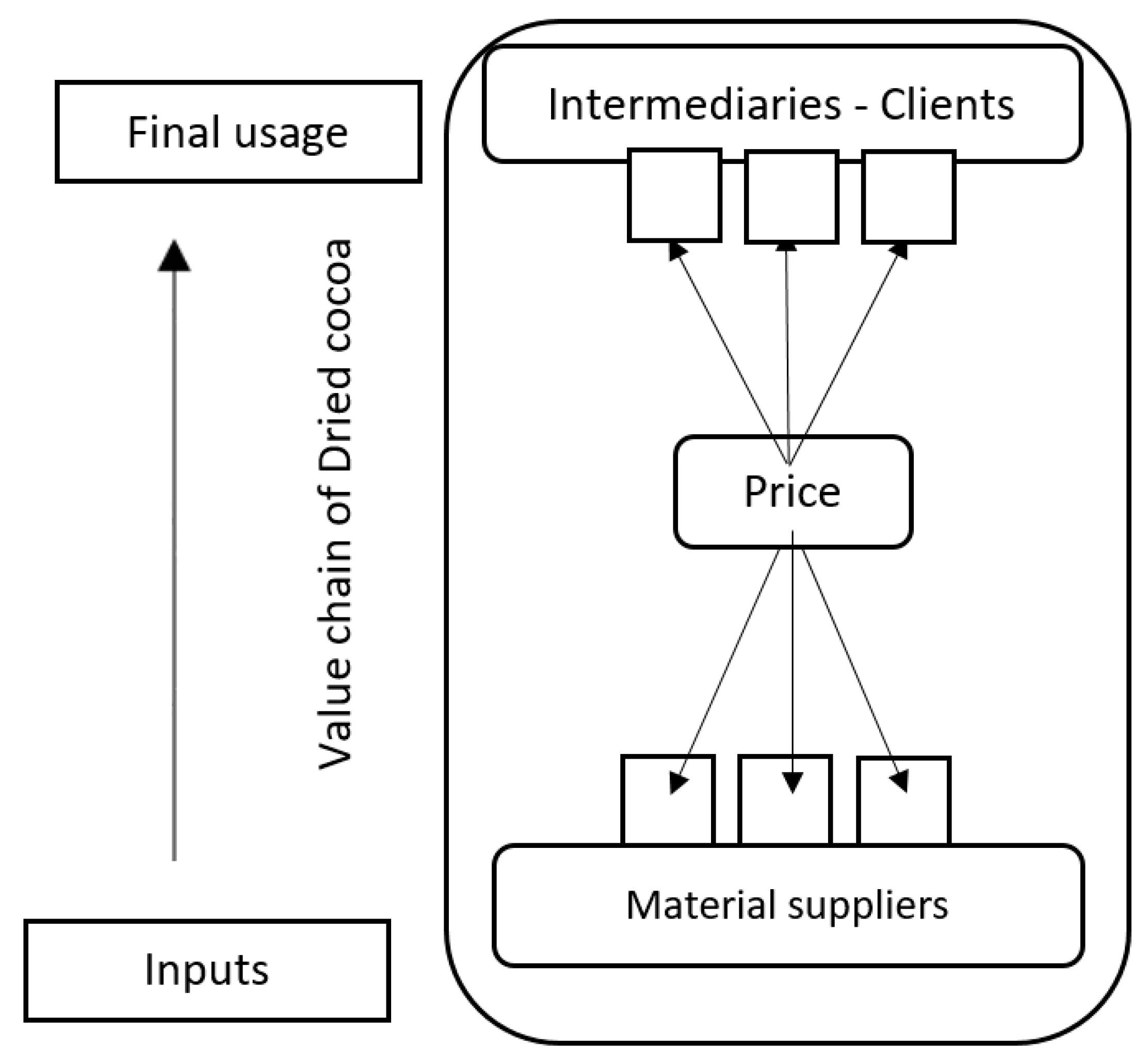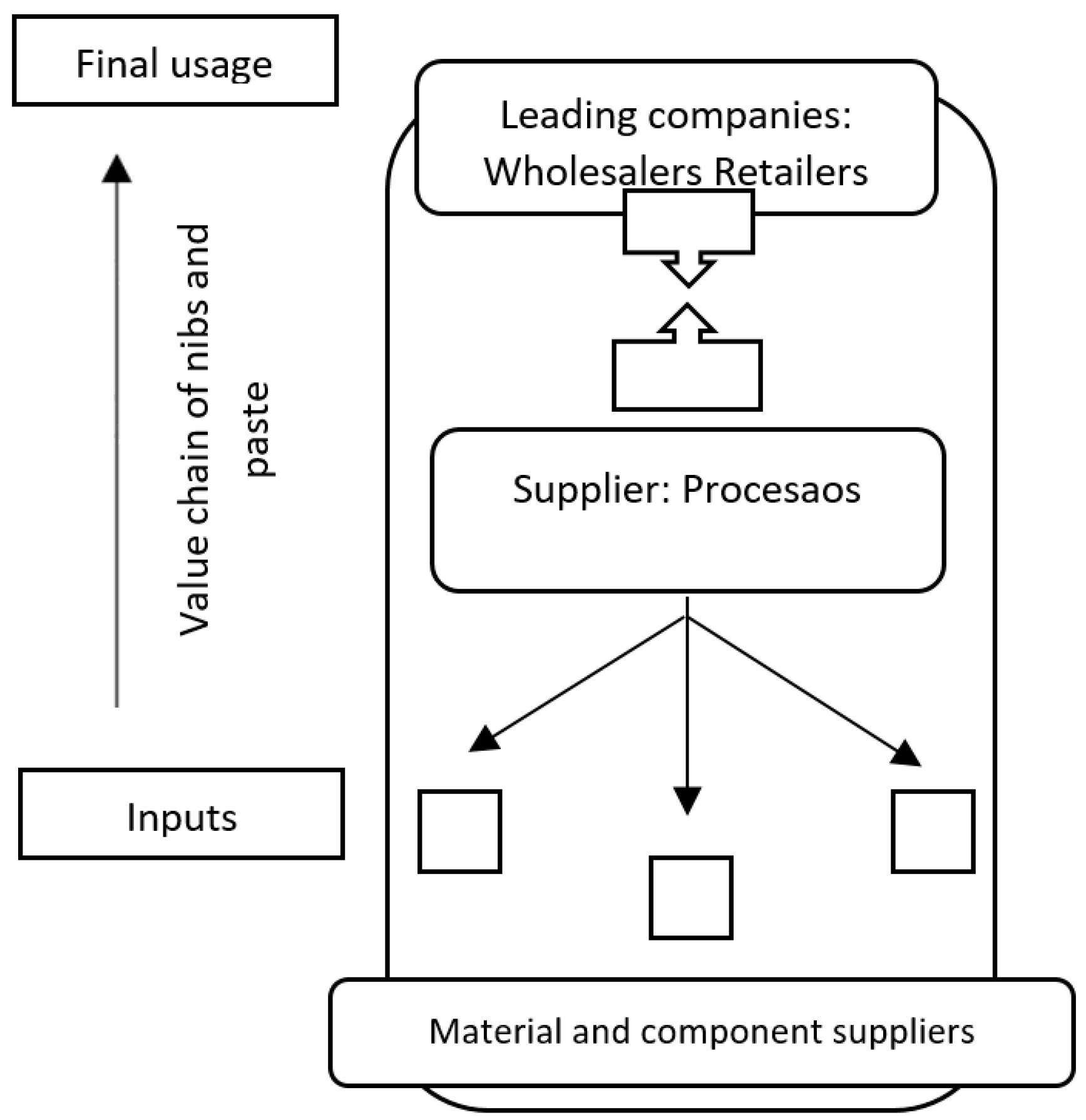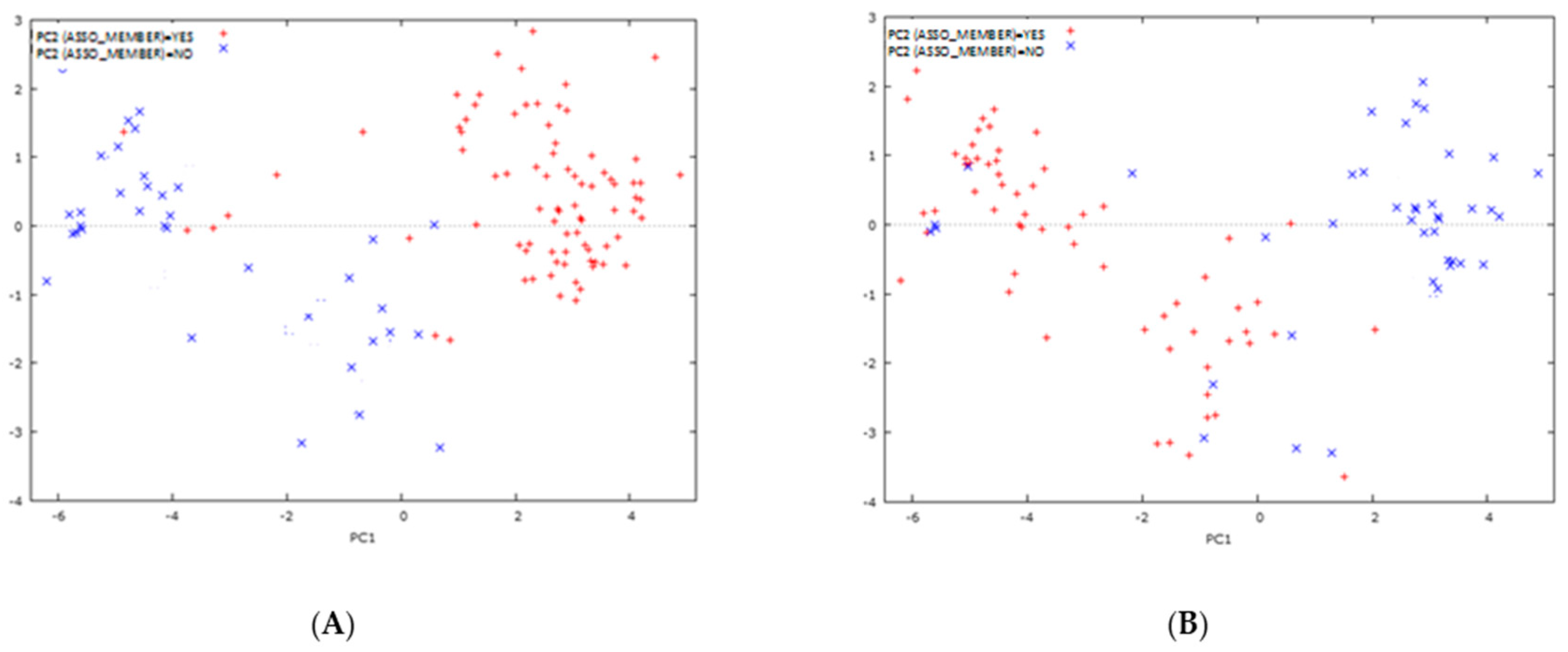1. Introduction
Cocoa (
Theobroma cacao L.) is cultivated mainly in Latin American countries and represents an important crop worldwide, for both processed and raw material markets [
1,
2]. African countries have led world production in recent years [
3,
4]. According to the United Nations Food and Agriculture Organization’s latest estimates, world production of cocoa is more than 4,600,000 tons per year, resulting from around 1,200,000 ha of cultivated land [
5]. Cameroon, Nigeria, Indonesia, Ghana, and Cote D’Ivoire are the primary producers of cocoa, making up 67% of total world production [
6]. Ecuador, with an output of 270,000 tons, placed ninth in the world ranking of cocoa-producing countries [
7]. In 2016, Ecuador was Latin America’s largest producer, making up 35% of cocoa production [
8]. However, in recent years, the Ecuadorian cocoa market faced troubles, and small producers fell victim to price volatility and poor contingency strategies to manage risk. This resulted in a deceleration of 5%, as compared to the 3.8% growth it had experienced during the 2015 fiscal year [
9].
According to the Ministry of Agriculture–MAG census [
10], the Ecuadorian coastal region is the central location of cocoa production, contributing more than 70% of the Ecuadorian output. Los Ríos and Guayas provinces account for the most extended surface area, covering around 35% of the total cocoa crop area. Ecuador grows two varieties of cocoa, Arriba that owns a deep floral-fruity aroma, and it is widely cultivated in Los Ríos province; and CCN-51 a cloned variety for high productivity, represent 30 and 70 percent of production, respectively [
11]. Nevertheless, the reality of Cocoa Arriba production reveals a weak business model that brings short-term instability. For example, research revealed a lack of appropriate remuneration to producers, and insufficient producer prices to compensate production costs [
12]. The United Nations Development Programme UNDP–Ecuador [
13] reported the consequences of this, including rural migration, which is between 1.5% and 2.5% per year, as well as an increase in the agricultural frontier, which causes a deforestation rate between 3.5% and 5% per year [
14]. Therefore, specific instruments promoting sustainable chains are vital. The Protected-Designation-of-Origin (PDO) tool, a name of a specific area that recognizes official rules to produce certain foods with unique characteristics, aligns with the spirit of the regulation, which aims to increase small producers’ welfare, and is coherent with sustainable governance mechanisms.
The Ecuadorian PDO cocoa is known as “Cacao Arriba”, and it is the symbolic product of Ecuador. During 2002, the Ministry of Agriculture led a process of Cocoa Arriba revaluation, through the project “Recovery of Production and Improvement of the Quality of National Cocoa” [
15]. In 2007, Ecuador submitted the designation of origin (DO) application for Cocoa Arriba and it was approved in 2013 [
16]. Today, Ecuador has the most significant world market share of Cocoa Arriba (63%). Its recognition by the international industry is due to its sensory characteristics (fruity and floral flavors); however, estimates indicate that less than 28% of cocoa exports correspond to Arriba cocoa [
17]. Thus, Cocoa Arriba PDO production is an essential alternative crop, able to underpin sustainability and rural development in agricultural sectors. Various authors argue that studies have only addressed agronomic aspects, such as post-harvest practices and pest management, but lack an integrated perspective. This perspective would include PDO standards application, economic evaluation, and social implications, which underline existing shortcomings [
18,
19]. Understanding gaps between standards and chain-level practices is paramount, in order to assess the potential for sustainable governance and to drive the transformation in agri-food chains.
In such a context, the present article aims to contribute by addressing two research questions. The first RQ is how is the Cocoa Arriba PDO chain different from the CCN-51 cocoa chain in terms of socio-economic performance? The last RQ is what kind of governance mechanism does the Cocoa Arriba PDO chain describe, and what sets it apart from the CCN-51 cocoa chain? As such, the study hopes to further our understanding of the socio-economic sustainability assessment and the relevant insight it might provide regarding the cocoa PDO chain. It focused on Los Ríos province, since it covers most of the Cocoa Arriba production in Ecuador.
4. Conclusions
Improving the social and economic sustainability performance of the agri-food networks would involve significant structural changes. As a sub-cluster of the agri-food sector, cocoa producers, traders, processors, and distributors have responded to rural development problems, associativity, and cost-efficiency. Market opportunities, together with regulations through certification tools, such as Protected Designations of Origin, look for supporting viable and fair agricultural activities. Sustainable status for cocoa chains has received attention in the existing literature. Environmental aspects related to soil conditions of crops, pest-management plans, and deforestation practices were examined extensively. Nevertheless, social conditions and economic performance have received little attention. This paper aimed to provide an initial comparison between two different chains, CCN-51, and Arriba PDO, by emphasizing PDO chain demographic, socio-economic situation, and the impact of these factors on economic performance outcomes. The paper’s aim was to highlight their effect on the sustainability of a PDO widely recognized at the world market level. While two research questions tackled this aim, the results showed marked differences between both cocoa chains. We also faced a scarcity of indicators of a holistic sustainability assessment. Such findings highlight the complexity of evaluating of sustainability conditions, encourage future discussion, and motivate frameworks to evaluate the cocoa chain comprehensively at all levels.
The results of our study suggest that the Arriba PDO chain shows a disadvantage in the age profile of its population, which constitutes a possible threat. The education level of Arriba workers, as well as their associativity, are lower. Regarding academic formation, actors required an integrated perspective to make decisions effectively. Likewise, differences in monthly income pointed out a drawback for Arriba cocoa PDO producers. Together, this information allowed us to conclude that market differentiation principals are essential to recognize the implications of a good PDO, and help producers receive fair benefits. The public entities in charge of monitoring the production of Cacao Arriba, and those that manage local and international market intelligence systems, have not been able to establish such a differentiation. This issue is the main fault presented by the PDO chain. Moreover, the strategies for the two circuits, CCN-51 and Arriba, are different. CCN-51 cocoa was designed for mass markets and the industrialization of comparable products [
65], such as nibs, cocoa powder, and degreased chocolate for toppings, among others. Cocoa Arriba is a good whose sensory potential must be exploited in consumer goods with a high degree of quality and differentiation, that is, in exclusive market segments.
Moreover, the study realized an urgent need for differentiated value-added procedures to address cost efficiency and improve margins for producers, SMEs, and entrepreneurs. In addition, governance played a crucial role in the performance of the PDO chain. Consequently, we confirm the inconsistency of equal establishment strategies for both chains, executed by public bodies. The modular governability of the PDO chain shows the need to design and strengthen precise information flows, that are aimed at achieving high value-added consumer goods. We believe that the market for processed Cocoa Arriba-based goods has full reception at the local level, and even more so in global markets [
66]. Europe, Asia, and North America are markets which demand this type of good. Regarding perception, actors of both chains mentioned agronomic factors, such as cocoa variety, land tenure, cultivation technique, number of crops, and post-harvest practices, as the main drivers of economic sustainability. The PDO chain showed little interest in the price mechanism, since the world market is expanding, and actors are looking for a significant transition towards a sustainable chain. Apart from that, findings concluded that future research on integrated ecological and institutional practices within the multi-level approach are necessary [
67]. Future studies must focus on different labor and agricultural practice regulations and policies, to monitor their significant role in the adoption of sustainable models.
